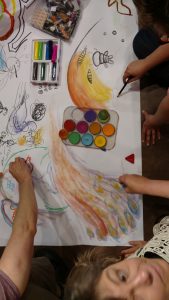 Last Friday was a GAS! I spent the day at Sketching in Practice, an amazing offering from Simon Fraser University and led by the incredible Jason Toal. In my next post I’ll recap more of the event as a whole, but I had an amazing time offering a one hour experimental session in the afternoon exploring the impact of the arrangement of space, offering of media and provision of (or not) of task constraints in how a group works together using visual practices. This is part of my preparation for the workshop Michelle Laurie and I are offering this September in Rossland, BC, My Pens, Our Pens: engagement through participatory visualization. More and more I want more than the visual harvest of graphic recording. I want to really dig into the practices that use collaborative and shared visuals for doing real learning and work. So this was a great opportunity.
Last Friday was a GAS! I spent the day at Sketching in Practice, an amazing offering from Simon Fraser University and led by the incredible Jason Toal. In my next post I’ll recap more of the event as a whole, but I had an amazing time offering a one hour experimental session in the afternoon exploring the impact of the arrangement of space, offering of media and provision of (or not) of task constraints in how a group works together using visual practices. This is part of my preparation for the workshop Michelle Laurie and I are offering this September in Rossland, BC, My Pens, Our Pens: engagement through participatory visualization. More and more I want more than the visual harvest of graphic recording. I want to really dig into the practices that use collaborative and shared visuals for doing real learning and work. So this was a great opportunity.
Here was the description of the session along with my initial planning sketch:
Session title: What if? An experiment to explore if/how structure, format and media influences our interactions
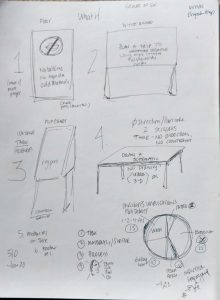 Session overview: Are you ready to be the principle investigator and subject for a short experiment? Join us in this hands on, fingers dirty, experiment on the impact of structure, format and media influences on our interactions with each other. You will be assigned a cohort upon entering the room, with some degree of instruction and materials. You will participate for 20 minutes with that cohort. Then we’ll do a gallery walk and debrief of the experience. Magic or mayhem? Or both? Let’s explore.
Session overview: Are you ready to be the principle investigator and subject for a short experiment? Join us in this hands on, fingers dirty, experiment on the impact of structure, format and media influences on our interactions with each other. You will be assigned a cohort upon entering the room, with some degree of instruction and materials. You will participate for 20 minutes with that cohort. Then we’ll do a gallery walk and debrief of the experience. Magic or mayhem? Or both? Let’s explore.
As people entered the room (about 35) I assigned them a number. The stations were preset around the room with a number showing on a card. I gave the briefest of brief introductions, as I wanted this to be about the experience, not explanations. The teams dispersed and upon “go” they turned over their cards which provided a brief set of directions (or lack thereof.) The teams then had 20 minutes. The stations included:
- Station 1: On the floor, a rich assortment of media, and task of simply drawing with no talking allowed. Media included regular markers, pan pastels and crayon markers.
- Station 2: On a table, no specified task and use only the media provided (dark and light chocolate bars in a bag!)
- Station 3: On table, provided media (regular markers and crayon markers), no task specified, team can only communicate by singing
- Station 4: On table, plan a trip from Vancouver BC to Seattle using only images/no words (but you can talk) with regular markers
- Station 5: Chairs in a circle, flip chart and pens nearby, task to identify a peer’s challenge and offer peer consultation.
- Station 6: On table, no directions or other constraints.
It was fascinating to watch. The table with just singing as the team communication directions quickly became a pretty frustrated set of people. One person made an effort at singing, but no one else joined in. The table paper became covered with words and images of frustration, along with some comments on their appreciation of the squishy markers that go on like lipstick. The trip planning team talked about their task. When one person put down the latitude demarcation, the whole flow just burst forward and everyone started drawing. The chocolate coloring folks, after a few moments of disbelief, jumped in and we all smelled the chocolate. (I have to admit, after a while the bars looked less like chocolate than some other substance…) The no directions team started out slow but got into the swing of things with a fairly broad and abstract image. The peer consultation group did not pull in the flip chart until I mentioned it halfway through but they appeared to be deep in conversation.
After the 20 minutes, teams had a few minutes to identify their key insights, then we did a gallery walk to each station to share insights. It was really interesting.
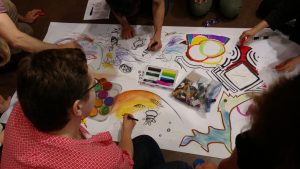 Station 1: People for the most part stuck with the area of paper they started with, and did beautiful, amazing images. One participant worked bigger and provided some marks that offered opportunities for connecting the individual areas. The team felt that if they had more time, this integration direction would have really kicked in. There were some comments about how yummy the richness of media were. (PAN PASTELS!!)
Station 1: People for the most part stuck with the area of paper they started with, and did beautiful, amazing images. One participant worked bigger and provided some marks that offered opportunities for connecting the individual areas. The team felt that if they had more time, this integration direction would have really kicked in. There were some comments about how yummy the richness of media were. (PAN PASTELS!!)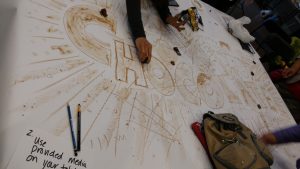 Station 2: The chocolate team had really dirty fingers! Despite the early disbelief, they embraced their medium. I think they also ate a bit of the chocolate, which seemed like a smart thing for me! Again, the initial marks by one member provided the start, role modeling that “embracing.” As we walked from station to station, this sense of the role of the “first person to make a move” proved very strong.
Station 2: The chocolate team had really dirty fingers! Despite the early disbelief, they embraced their medium. I think they also ate a bit of the chocolate, which seemed like a smart thing for me! Again, the initial marks by one member provided the start, role modeling that “embracing.” As we walked from station to station, this sense of the role of the “first person to make a move” proved very strong.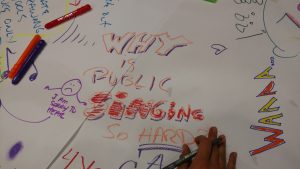 Station 3: The singing only table had a fascinating discussion about the fear of singing in public and we contrasted that with the fear of drawing in public. We realized that the fear of singing made the fear of drawing seem less intense, so maybe moving people WAAAAY beyond their initial comfort zones (to singing), then stepping back (to drawing) might be a way to frame and reflect on our fears. That said, there were some lovely individual marks on the paper. AND a lot more text than I’ve seen when I’ve done this exercise before.
Station 3: The singing only table had a fascinating discussion about the fear of singing in public and we contrasted that with the fear of drawing in public. We realized that the fear of singing made the fear of drawing seem less intense, so maybe moving people WAAAAY beyond their initial comfort zones (to singing), then stepping back (to drawing) might be a way to frame and reflect on our fears. That said, there were some lovely individual marks on the paper. AND a lot more text than I’ve seen when I’ve done this exercise before.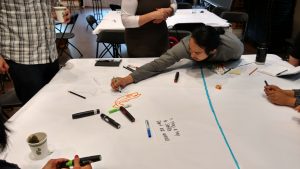 Station 4: The trip planners said they really bonded as a team. They were worried they were going to be broken up to other teams and did not like that idea. Of all the teams, there was the greatest sense of “team!”
Station 4: The trip planners said they really bonded as a team. They were worried they were going to be broken up to other teams and did not like that idea. Of all the teams, there was the greatest sense of “team!” Station 5: The consultation team had to pull in some additional chairs which were higher than the initial comfy chairs, raising the observation about power as manifest in the set up – the higher chair people felt they had to lean in more, and the lower chairs were perhaps more quiet. That said, they had a productive peer consultation. Visuals appeared to be a minimal part of their experience. It made me wonder about how explicit we need to be with both the provision of visual tools and suggestions for use. They don’t appear to be a default.
Station 5: The consultation team had to pull in some additional chairs which were higher than the initial comfy chairs, raising the observation about power as manifest in the set up – the higher chair people felt they had to lean in more, and the lower chairs were perhaps more quiet. That said, they had a productive peer consultation. Visuals appeared to be a minimal part of their experience. It made me wonder about how explicit we need to be with both the provision of visual tools and suggestions for use. They don’t appear to be a default.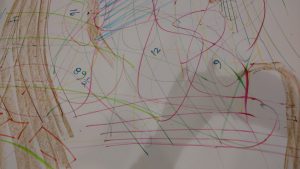 Station 6: One tweet out of the no directions group cracked me up – something to the effect of “this is my favorite kind of direction!” They noted that there was some sense of wanting direction or leadership, but after one person made some marks, again, things flowed. However, they wanted chocolate, so they traded some markers with the chocolate folks.
Station 6: One tweet out of the no directions group cracked me up – something to the effect of “this is my favorite kind of direction!” They noted that there was some sense of wanting direction or leadership, but after one person made some marks, again, things flowed. However, they wanted chocolate, so they traded some markers with the chocolate folks.
My sense is that most of the people enjoyed the experience in the end, even if they experienced frustration or remorse that they were not in a particular group. There was a lot of interest in both the dynamics of the space/constraint/media question, but the new element that came up for me was the role of the first mark, who makes it, and how they make it. This sets the tone.
If this intrigues you, consider joining us for the workshop My Pens, Our Pens: engagement through participatory visualization.
Here is the photo set on Flickr:
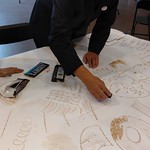
This is so like you, Nancy, and SO FRICKIN COOL!!! I would have LOVED to be there! 🙂
Thanks so much for sharing what happened… All kinds of ideas are swimming in my head about how I can play… I want to play too!